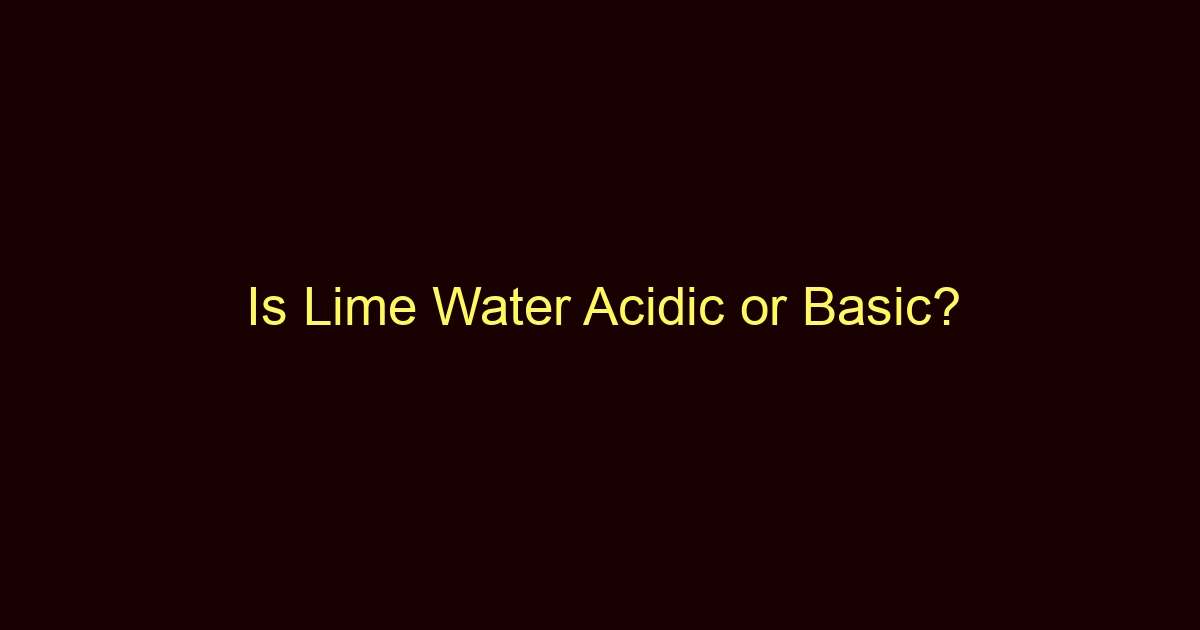Lime water is basic in nature. It has a pH level that usually falls between 9 and 12.
Lime water has been a topic of conversation lately, especially among those who are health-conscious or interested in natural remedies. The question often arises: is lime water acidic or basic? While lime juice is acidic, lime water—which is made by dissolving calcium hydroxide in water—is actually basic. This might come as a surprise to many people who generally associate anything with “lime” as being acidic. Understanding the pH level of lime water is crucial, not just for scientific purposes, but also for its various applications, ranging from culinary arts to construction.
Is Lime Water Acidic?
No, lime water is not acidic; it is basic.
Lime water is not to be confused with lime juice. Lime juice comes from the lime fruit and is acidic in nature. However, lime water is made by dissolving calcium hydroxide in water and is basic. The basicity of lime water can be confusing to some people who often consider all citrus-related liquids to be acidic. It’s crucial to understand that while they share a name, lime water and lime juice are chemically very different.
One of the key differences lies in their respective pH levels. While lime juice has a low pH level, indicating acidity, lime water has a high pH level, signifying its basic nature. The basicity of lime water has various applications, like water treatment and as a culinary ingredient in specific recipes. Moreover, this high pH level has led to its use in construction, for mixing mortars and plasters, showing the versatility of this simple yet chemically interesting liquid.
Is Lime Water Basic?
Yes, lime water is basic; it has a pH that usually falls between 9 and 12.
Yes, lime water is basic, and this basicity has some fascinating applications. Lime water is often used as an antacid to neutralize stomach acids, providing relief from indigestion and heartburn. It reacts with the acids, forming water and other by-products that are less harmful than the aggressive stomach acids. Basic substances like lime water are useful in such applications, where a substance’s pH plays a significant role in its effectiveness.
Apart from its medical applications, lime water is also used in water treatment plants to neutralize acidic substances in the water, making it safe for consumption. It plays a pivotal role in removing impurities from the water. This makes lime water a versatile agent in various fields. Whether you’re in the field of medicine, water treatment, or even cuisine, understanding the basic nature of lime water can be highly beneficial.
pH Values of Lime Water
The pH of lime water usually falls between 9 and 12, classifying it as a basic or alkaline substance. pH is a scale that measures the acidity or basicity of a solution, and anything with a pH level above 7 is considered basic. Given its pH range, lime water is far from being acidic. It’s essential to remember these pH levels when considering the applications of lime water, whether that’s for cooking, health remedies, or even water treatment.
Final Thoughts
In summary, lime water is a basic liquid with a pH level that ranges between 9 and 12. It’s vital to differentiate between lime water and lime juice, as they serve very different purposes due to their varying pH levels. While lime juice is acidic and is often used for its tangy flavor or preservative properties, lime water is basic and is utilized in a multitude of applications from health remedies to water treatment.
Understanding the nature of lime water can help in various fields and applications. Not only does its basicity make it useful in neutralizing acids, but it also plays a significant role in making water safe for consumption. The versatility and importance of lime water can’t be overstated, making it a subject worthy of attention.

